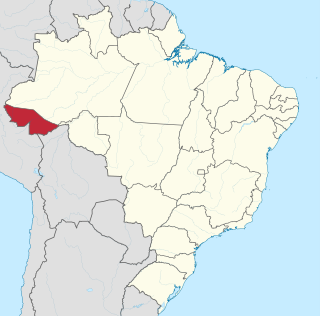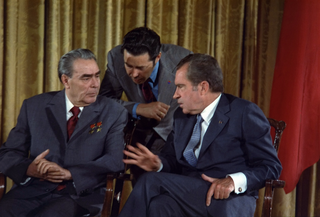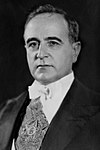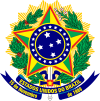Related Research Articles

Angola was first settled by San hunter-gatherer societies before the northern domains came under the rule of Bantu states such as Kongo and Ndongo. In the 15th century, Portuguese colonists began trading, and a settlement was established at Luanda during the 16th century. Portugal annexed territories in the region which were ruled as a colony from 1655, and Angola was incorporated as an overseas province of Portugal in 1951. After the Angolan War of Independence, which ended in 1974 with an army mutiny and leftist coup in Lisbon, Angola achieved independence in 1975 through the Alvor Agreement. After independence, Angola entered a long period of civil war that lasted until 2002.

Acre ( ) is a state located in the west of the North Region of Brazil and the Amazonia Legal. Located in the westernmost part of the country, at a two-hour time difference from Brasília, Acre is bordered clockwise by the Brazilian states of Amazonas and Rondônia to the north and east, along with an international border with the Bolivian department of Pando to the southeast, and the Peruvian regions of Madre de Dios, Ucayali and Loreto to the south and west. Its capital and largest city is Rio Branco. Other important places include Cruzeiro do Sul, Sena Madureira, Tarauacá and Feijó. The state, which has 0.42% of the Brazilian population, generates 0.2% of the Brazilian GDP.

The First Brazilian Republic, also referred to as the Old Republic, officially the Republic of the United States of Brazil, refers to the period of Brazilian history from 1889 to 1930. The Old Republic began with the deposition of Emperor Pedro II in 1889, and ended with the Brazilian Revolution of 1930 that installed Getúlio Vargas as a new president. During the First Brazilian Republic, Brazil was dominated by a form of machine politics known as coronelism, in which the political and economic spheres were dominated by large landholders. The most powerful of such landholders were the coffee industry of São Paulo and the dairy industry of Minas Gerais. Because of the power of these two industries, the Old Republic's political system has been described as "milk coffee politics."

Détente is the relaxation of strained relations, especially political ones, through verbal communication. The diplomacy term originates from around 1912, when France and Germany tried unsuccessfully to reduce tensions.

The Vargas Era is the period in the history of Brazil between 1930 and 1945, when the country was governed by president Getúlio Vargas. The period from 1930 to 1937 is known as the Second Brazilian Republic, and the other part of Vargas Era, from 1937 until 1946 is known as the Third Brazilian Republic.

The Paris Peace Accords,, officially the Agreement on Ending the War and Restoring Peace in Viet Nam, was a peace agreement signed on January 27, 1973, to establish peace in Vietnam and end the Vietnam War. The agreement was signed by the governments of the Democratic Republic of Vietnam ; the Republic of Vietnam ; the United States; and the Provisional Revolutionary Government of the Republic of South Vietnam (PRG), which represented South Vietnamese communists. US ground forces had begun to withdraw from Vietnam in 1969, and had suffered from deteriorating morale during the withdrawal. By the beginning of 1972 those that remained had very little involvement in combat. The last American infantry battalions withdrew in August 1972. Most air and naval forces, and most advisers, also were gone from South Vietnam by that time, though air and naval forces not based in South Vietnam were still playing a large role in the war. The Paris Agreement removed the remaining US forces. Direct U.S. military intervention was ended, and fighting between the three remaining powers temporarily stopped for less than a day. The agreement was not ratified by the U.S. Senate.

Edwin James Barclay was a Liberian politician, poet, and musician who served as the 18th president of Liberia from 1930 until 1944. He was a member of the True Whig political party, which dominated the political governance of the country for decades. Under Barclay's leadership, Liberia was an ally of the United States during World War II.

The Casablanca Conference or Anfa Conference was held in Casablanca, French Morocco, from January 14 to 24, 1943, to plan the Allied European strategy for the next phase of World War II. The main discussions were between US President Franklin Roosevelt and British Prime Minister Winston Churchill. Stalin could not attend. Key decisions included a commitment to demand Axis powers' unconditional surrender; plans for an invasion of Sicily and Italy before the main invasion of France; an intensified strategic bombing campaign against Germany; and approval of a US Navy plan to advance on Japan through the central Pacific and the Philippines. The last item authorized the island-hopping campaign in the Pacific, which shortened the war. Of all the decisions made, the most important was the invasion of Sicily, which Churchill pushed for in part to divert American attention from opening a second front in France in 1943, a move that he feared would result in very high Allied casualties and not be possible until 1944.

The Inter-American Treaty of Reciprocal Assistance is an agreement signed in 1947 in Rio de Janeiro among many countries of the Americas. The central principle contained in its articles is that an attack against one is to be considered an attack against them all; this was known as the "hemispheric defense" doctrine. Despite this, several members have breached the treaty on multiple occasions. The treaty was initially created in 1947 and came into force in 1948, in accordance with Article 22 of the treaty. The Bahamas was the most recent country to sign and ratify it in 1982.
The Bicesse Accords, also known as the Estoril Accords, laid out a transition to multi-party democracy in Angola under the supervision of the United Nations' UNAVEM II mission. President José Eduardo dos Santos of the MPLA and Jonas Savimbi of UNITA signed the accord in Lisbon, Portugal on May 31, 1991. UNITA rejected the official results of the 1992 presidential election as rigged and renewed their guerrilla war.

Historically speaking, bilateral relations between the various countries of Latin America and the United States of America have been multifaceted and complex, at times defined by strong regional cooperation and at others filled with economic and political tension and rivalry. Although relations between the U.S. government and most of Latin America were limited prior to the late 1800s, for most of the past century, the United States has unofficially regarded parts of Latin America as within its sphere of influence, and for much of the Cold War (1947–1991), actively vied with the Soviet Union for influence in the Western Hemisphere.

The United States was, in 1824, the second country to recognize the independence of Brazil, after Argentina did it in 1823. Brazil was the only South American nation to send troops to fight in Europe alongside the Allies in World War II.

The Amazon rubber cycle, or boom was an important part of the economic and social history of Brazil and Amazonian regions of neighboring countries, being related to the extraction and commercialization of rubber. Centered in the Amazon Basin, the boom resulted in a large expansion of European colonization in the area, attracting immigrant workers, generating wealth, causing cultural and social transformations, and wreaking havoc upon indigenous societies. It encouraged the growth of cities such as Manaus and Belém, capitals within the respective Brazilian states of Amazonas and Pará, among many other cities throughout the region like Itacoatiara, Rio Branco, Eirunepé, Marabá, Cruzeiro do Sul and Altamira; as well as the expansion of Iquitos in Peru, Cobija in Bolivia and Leticia in Colombia. The first rubber boom occurred largely between 1879 and 1912. There was heightened rubber production and associated activities again from 1942 to 1945 during the Second World War.
Plan Rubber was the codename given to military plans of the United States for the occupation of the Northern coast of Brazil during World War II. The plan was raised in response to concerns that Brazil would enter the war on the side of the Axis, or would at least act in a manner sympathetic to the Axis cause.
The Washington Agreement was a peace agreement that led to the modern Bosnia and Herzegovina, signed in 1994.

Before the arrival of the Europeans, the lands that now constitute Brazil were occupied, fought over and settled by diverse tribes. Thus, the history of Brazil begins with the indigenous people in Brazil. The Portuguese arrived to the land that would become Brazil on April 22, 1500, commanded by Pedro Álvares Cabral, an explorer on his way to India under the sponsorship of the Kingdom of Portugal and the support of the Catholic Church.

The Oslo Accords are a pair of agreements between Israel and the Palestine Liberation Organization (PLO): the Oslo I Accord, signed in Washington, D.C., in 1993; and the Oslo II Accord, signed in Taba, Egypt, in 1995. They marked the start of the Oslo process, a peace process aimed at achieving a peace treaty based on Resolution 242 and Resolution 338 of the United Nations Security Council, and at fulfilling the "right of the Palestinian people to self-determination". The Oslo process began after secret negotiations in Oslo, Norway, resulting in both the recognition of Israel by the PLO and the recognition by Israel of the PLO as the representative of the Palestinian people and as a partner in bilateral negotiations.
Rubber soldiers were people in Brazil which were compulsorily drafted to harvest rubber in the Amazon rainforest during World War II.

During World War II, a number of significant economic, political, and military changes took place in Latin America. The war caused considerable panic in the region over economics as large portions of economy of the region depended on the European investment capital, which was shut down. Latin America tried to stay neutral at first but the warring countries were endangering their neutrality. In order to better protect the Panama Canal, combat Axis influence, and optimize the production of goods for the war effort, the United States through Lend-Lease and similar programs greatly expanded its interests in Latin America, resulting in large-scale modernization and a major economic boost for the countries that participated.

Diplomatic relations between Brazil and Poland were first established in 1920. Over 800,000 Brazilians are of Polish descent making Brazil the second country with the largest Polish community abroad. Both nations are members of the United Nations.
References
- ↑ "The Brazilian Participation in World War II", Carlos José Asumpção Penteado, 2006, a Master of Military Art and Science thesis
- ↑ "Records of International Military Agencies". National Archives. 2016-08-15. Retrieved 2021-08-31.

